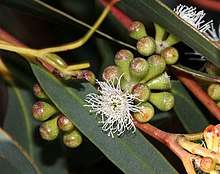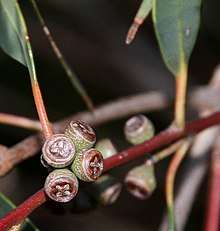Eucalyptus willisii
Eucalyptus willisii, also known as shining peppermint or promontory peppermint,[2] is a species of small to medium-sized tree, sometimes a mallee that is endemic to Victoria, Australia. It has rough, fibrous bark on the trunk and branches, lance-shaped to curved adult leaves, flower buds in groups of eleven to twenty five, white flowers and cup-shaped or hemispherical fruit.
| Shining peppermint | |
|---|---|
 | |
| Flower buds of E. willisii in Wilsons Promontory N.P. | |
| Scientific classification | |
| Kingdom: | Plantae |
| Clade: | Tracheophytes |
| Clade: | Angiosperms |
| Clade: | Eudicots |
| Clade: | Rosids |
| Order: | Myrtales |
| Family: | Myrtaceae |
| Genus: | Eucalyptus |
| Species: | E. willisii |
| Binomial name | |
| Eucalyptus willisii | |

Description
Eucalyptus willisii is a tree or a mallee that typically grows to a height of 10 m (33 ft) and forms a lignotuber. It has rough, fibrous bark on the trunk and larger branches. Young plants and coppice regrowth have slightly glossy, sessile, lance-shaped or curved leaves that are 64–85 mm (2.5–3.3 in) long, 18–29 mm (0.71–1.14 in) wide and arranged in opposite pairs. Adult leaves are arranged alternately, the same shade of dull to slightly glossy blue-green on both sides, 60–170 mm (2.4–6.7 in) long and 7–23 mm (0.28–0.91 in) wide tapering to a petiole 6–18 mm (0.24–0.71 in) long. The flower buds are arranged in leaf axils in groups of eleven to twenty five on an unbranched peduncle 2–8 mm (0.079–0.315 in) long, the individual buds on pedicels 2–4 mm (0.079–0.157 in) long. Mature buds are oval to club-shaped, 3–5 mm (0.12–0.20 in) long and about 3 mm (0.12 in) wide with a hemispherical operculum. Flowering occurs from September to January and the flowers are white. The fruit is a woody cup-shaped capsule 4–6 mm (0.16–0.24 in) long and wide on a pedicel 1–4 mm (0.039–0.157 in) long with three or four valves near rim level. The seeds are smooth and glossy, brown to dark brown and pyramid-shaped but are distorted along one curved face.[3][4][5]
Taxonomy and naming
Eucalyptus willisii was first formally described in 1983 by Pauline Ladiges, Chris Humphries and Ian Brooker in the Australian Journal of Botany from specimens collected near Mount Oberon in Wilsons Promontory National Park in 1982.[6] The specific epithet (willisii) honours James Hamlyn Willis (1910 – 1995).[4][7]
Distribution
The shining peppermint is endemic to Victoria from Cranbourne to around Bairnsdale in the west, and south to Wilsons Promontory[2] where it is found growing in sandy areas or on granite hills in scrubland communities.[3]
See also
References
- "Eucalyptus willisii". Australian Plant Census. Retrieved 22 January 2020.
- "Eucalyptus willisii Shining Peppermint, Promontory Peppermint". TreeProject. Retrieved 19 September 2019.
- "Eucalyptus willisii P.Ladiges". VicFlora. Royal Botanic Gardens Victoria. Retrieved 19 September 2019.
- "Eucalyptus willisii subsp. willisii". Euclid: Centre for Australian National Biodiversity Research. Retrieved 27 May 2020.
- Chippendale, George M. "Eucalyptus willisii". Australian Biological Resources Study, Department of the Environment and Energy, Canberra. Retrieved 21 January 2020.
- "Eucalyptus willisii". APNI. Retrieved 21 January 2020.
- "Willis, James (Jim) Hamlyn (1910 - 1995)". Council of Heads of Australasian Herbaria Australian National Herbarium. Retrieved 21 January 2020.